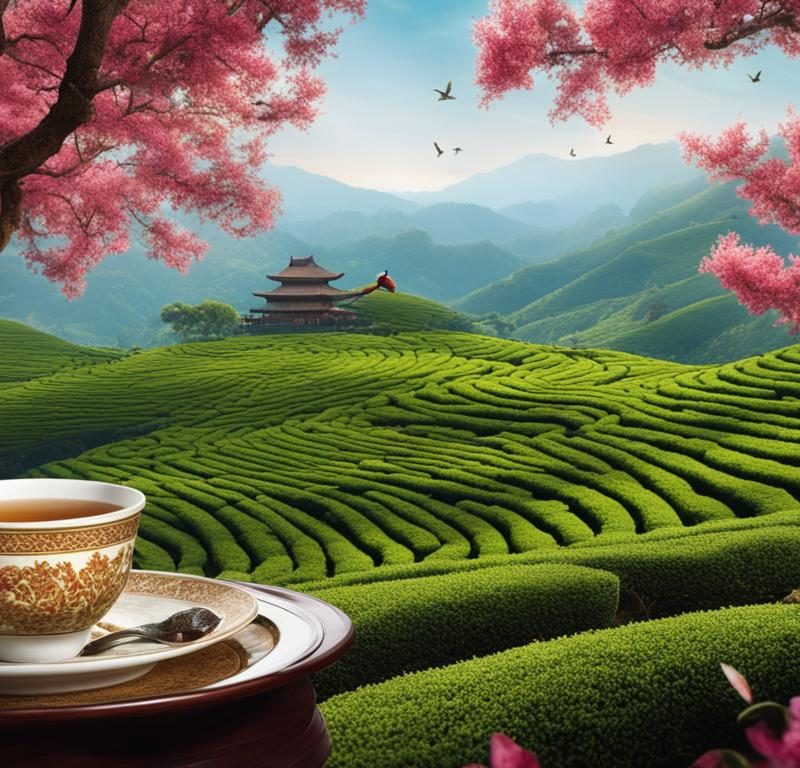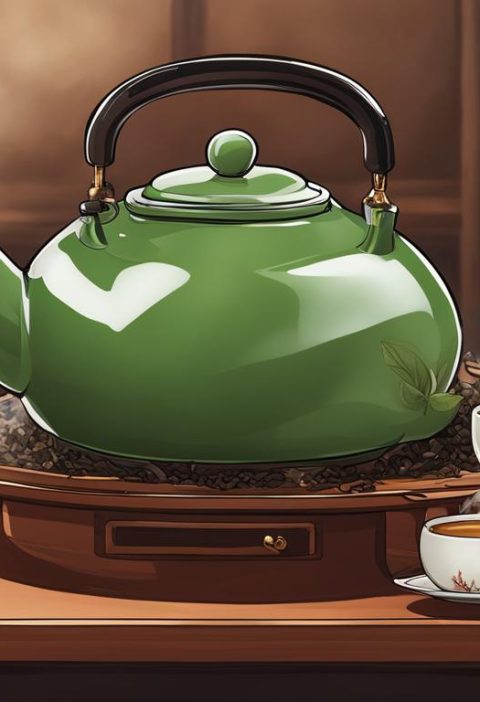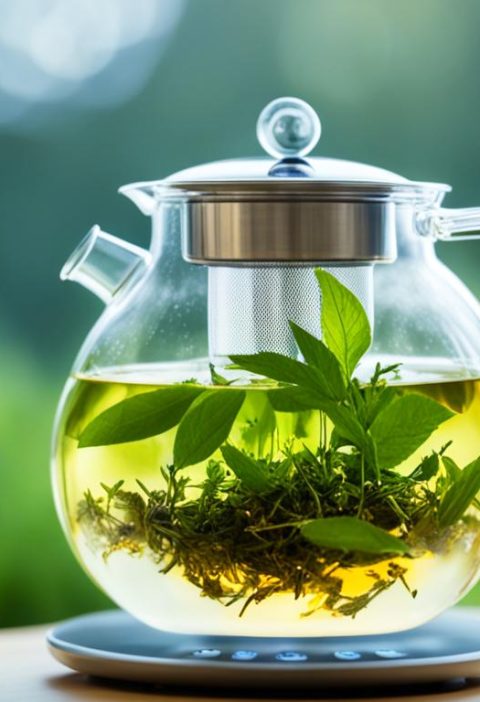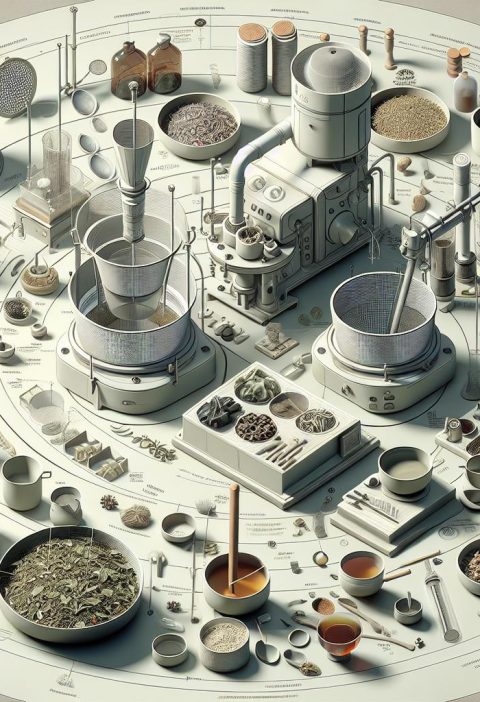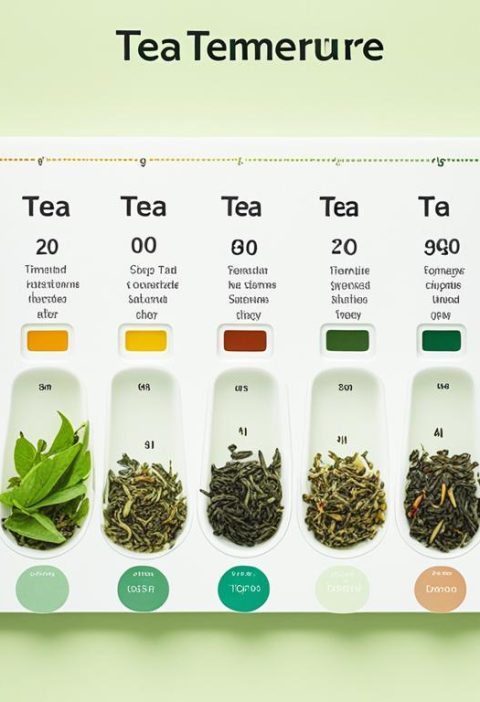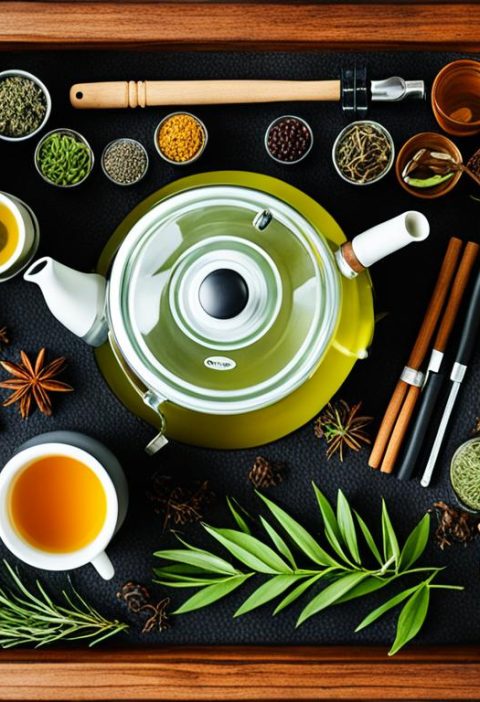The world of rare teas offers a unique opportunity for tea connoisseurs and investors alike. As the demand for luxury tea options continues to grow, exploring rare and premium tea selections has become an intriguing investment avenue. By delving into the realm of specialty teas, one can discover a selection of high-quality tea leaves and valuable tea varieties that are highly sought-after. In this guide, we will explore the luxury tea options and premium tea selections that are worth considering as an investment in the world of rare teas.
Key Takeaways:
- Investing in rare teas is an opportunity to explore high-quality and valuable tea varieties.
- Rare teas are sought-after luxury options and offer a unique investment avenue.
- By delving into the world of specialty teas, you can discover premium tea selections.
- Exploring rare teas is an invitation to savor unique tea experiences.
- Rare teas hold the potential for appreciation in value and add uniqueness to investment portfolios.
The Importance of Sourcing and Sustainability in Tea Production
The sourcing process of rare teas is crucial in ensuring the quality and authenticity of the product. At our Rare Tea Company, we take pride in being an independent tea business that directly collaborates with tea farmers to bring you the finest rare teas. By avoiding exploitative systems or businesses, we establish a transparent and fair partnership with the growers.
Investing in rare teas goes beyond personal enjoyment; it can contribute to long-term sustainable change. Through initiatives like the Rare Charity, we support educational scholarships for tea growers. Many of these growers, who supply mass-market brands, often live in poverty and have limited life expectancy. By investing in our rare teas, you play a part in empowering these communities and helping them achieve a better future.
| Sourcing Approach | Sustainability Impact |
|---|---|
| Direct collaboration with tea farmers | – Ensures fair and ethical practices – Supports local economies – Preserves traditional tea-growing techniques |
| Avoidance of exploitative systems or businesses | – Reduces income inequality – Promotes economic empowerment – Enhances the quality of life for tea growers |
| Scholarship programs through the Rare Charity | – Provides education opportunities – Empowers tea growers to break the cycle of poverty – Enhances long-term sustainability |
The Parallels Between Fine Tea and Fine Wine
Fine tea and fine wine hold a remarkable connection, as both share a deep appreciation for the artistry behind their creation. Like fine wine, the quality and character of fine tea are influenced by various factors such as terroir, varietal selection, distance above sea level, and the picking season.
Terroir, a term commonly associated with wine, refers to the environmental conditions in which the tea bush grows. The soil, climate, and geographic location all contribute to the unique flavor nuances found in fine teas. Just as different grape varieties thrive in specific regions, tea plants also flourish under specific terroirs, resulting in distinct taste profiles.
Varietal selection is another key factor that impacts both tea and wine. Different tea plant varieties, known as cultivars, offer diverse flavor profiles, much like different grape varieties used in winemaking. From the delicate floral notes of a green tea cultivar to the robust flavors of a black tea cultivar, the choice of varietals plays a significant role in the final product.
The distance above sea level at which tea is grown also contributes to its unique characteristics. Tea plants grown at higher elevations often experience lower temperatures and increased humidity, resulting in slower growth. This slower growth allows the tea leaves to develop more concentrated flavors, imparting a complexity and depth that is highly sought-after.
Furthermore, the picking season of tea leaves is crucial in determining the flavor profile of the final product, just as the timing of grape harvest affects the quality of wine. The first flush, or the initial harvest of spring, often produces teas with delicate and nuanced flavors. Subsequent harvests may yield teas with different characteristics due to changes in weather conditions and maturation of the tea leaves.
Understanding the parallels between fine tea and fine wine is essential when investing in rare teas. By appreciating the impact of terroir, varietal selection, distance above sea level, and picking season, we can choose teas that offer exceptional flavor experiences and represent the best qualities of this ancient beverage.
Fine Tea and Fine Wine Parallels:
- Both fine tea and fine wine are influenced by terroir, which includes factors like soil, climate, and geographic location.
- Varietal selection plays a crucial role in determining the flavor profile of both tea and wine.
- The altitude at which tea is grown influences its unique characteristics and flavor complexity, similar to wine grapes grown at different elevations.
- The timing of tea leaf picking season affects the flavor nuances, just as the timing of grape harvest impacts the quality of wine.
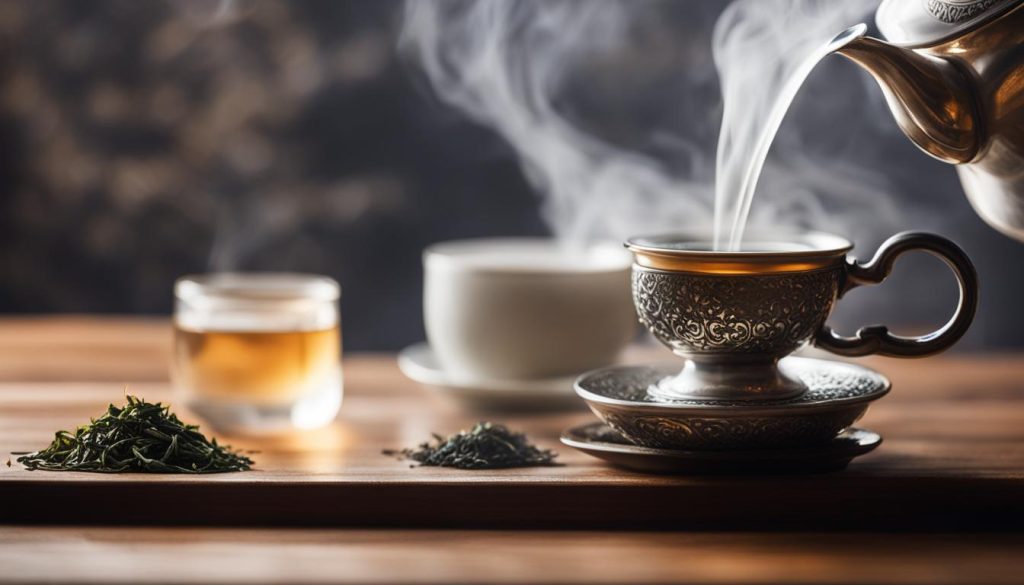
| Parallels | Fine Tea | Fine Wine |
|—|—|—|
| Terroir | Influences flavor through soil, climate, and geography | Influences flavor through soil, climate, and geography |
| Varietal Selection | Different tea plant varieties provide diverse flavor profiles | Different grape varieties provide diverse flavor profiles |
| Altitude | Higher elevation yields teas with concentrated flavors | Vineyards at higher elevation produce distinct flavors |
| Picking Season | First flush produces delicate teas, subsequent harvests may have different characteristics | Harvest timing affects grape ripeness and resulting wine flavors |
By recognizing the parallels between fine tea and fine wine, we can better appreciate the complexities of teas and make informed decisions as we embark on our tea journey.
The Expertise of Fine Tea Specialists
Fine tea specialists are invaluable when it comes to navigating the intricate world of rare teas. These experts have immersed themselves in the rich tea culture, dedicating years to acquiring extensive knowledge and understanding various dialects related to tea. With their profound expertise, they play a pivotal role in assisting connoisseurs in sourcing the finest rare teas that align with their preferences and investment goals.
When seeking rare teas, it is essential to rely on the guidance of these fine tea experts. Their deep understanding of the tea market and their connections within the industry enable them to offer valuable insights and recommendations. Whether you are a tea enthusiast exploring new flavors or an investor looking to add rare teas to your collection, the expertise of fine tea specialists is invaluable in ensuring a satisfying and rewarding journey.
The Role of Tea Knowledge and Immersion in Tea Culture
Tea knowledge is not something that can be acquired overnight. Fine tea specialists invest years in studying and understanding the nuances of tea production, including tea varieties, processing methods, and brewing techniques. Through their immersion in tea culture, they develop a keen sense of discernment that allows them to identify teas of exceptional quality.
Furthermore, fine tea specialists often build strong relationships with tea farmers and suppliers, enabling them to access rare teas that may be difficult for others to obtain. Their connections and deep involvement in the tea industry give them a unique advantage when it comes to sourcing rare and exceptional teas.
Ultimately, the expertise of these fine tea specialists is rooted in their passion for tea. Their unwavering dedication and commitment to exploring the vast tea landscape result in a depth of knowledge that can enrich the tea-drinking experience for enthusiasts and investors alike.
| Benefits of Consulting Fine Tea Specialists |
|---|
| Extensive knowledge of rare teas |
| Access to hard-to-find teas |
| Guidance in selecting teas that match preferences |
| Expert advice on tea investment opportunities |
Understanding the Complexity and Variety of Fine Teas
Fine teas are a true embodiment of complexity and diversity, reminiscent of the intricacies found in fine wines. Similar to how different wines offer unique flavor profiles, the world of fine teas presents an extensive range of tastes, aromas, and textures that can captivate tea enthusiasts. The complex nature of fine teas arises from various factors, including the tea cultivar, growing conditions, processing methods, and regional influences.
When exploring the realm of fine teas, it’s essential to understand that many of the most exquisite and sought-after teas originate from China and Japan. The centuries-old tea traditions and meticulous craftsmanship in these countries have resulted in tea varieties that are renowned worldwide for their exceptional quality.
Sourcing these hard-to-find teas can be a challenge, especially for tea lovers residing outside of Asia. However, with the guidance of experienced fine tea specialists, such as Jameel Lalani, founder of Lalani & Co, the journey to obtain these elusive teas becomes more accessible. Jameel Lalani’s vast knowledge and well-established connections in the fine tea industry provide a gateway to acquiring rare teas that offer unparalleled experiences.
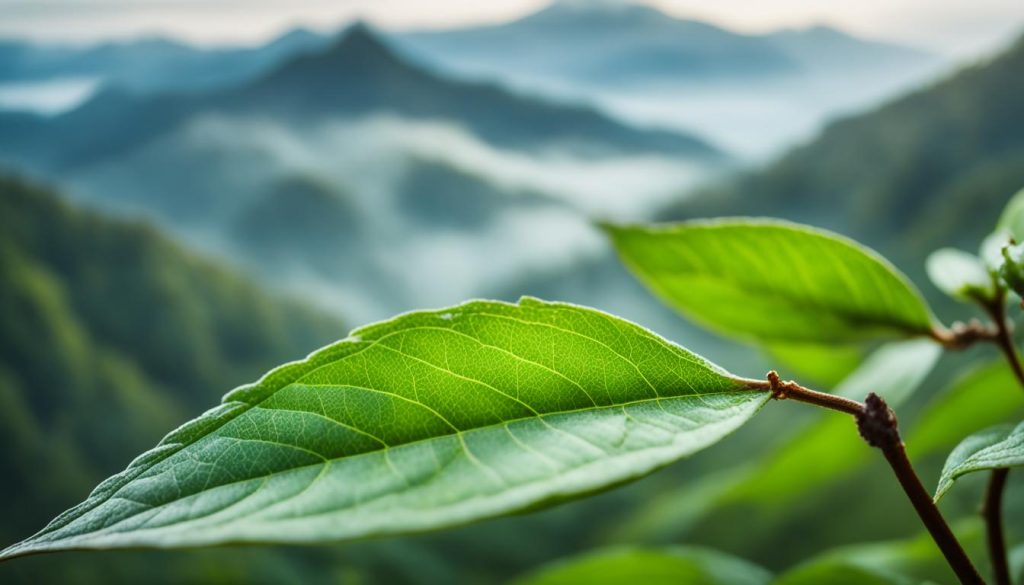
The Fine Tea Varieties of China and Japan
China and Japan have cultivated a rich tea heritage, producing a wide selection of teas that showcase the exceptional craftsmanship and distinct terroir of each region. Here are some notable examples of Chinese and Japanese teas:
| Chinese Teas | Japanese Teas |
|---|---|
| Longjing (Dragon Well) | Matcha |
| Tie Guan Yin (Iron Goddess of Mercy) | Sencha |
| Pu-erh | Gyokuro |
| Da Hong Pao (Big Red Robe) | Hojicha |
Each of these teas offers a unique flavor profile and brewing experience, representing the diversity of Chinese and Japanese tea culture. From the delicate sweetness of Longjing to the robust earthiness of Pu-erh, every sip unveils an intricate tapestry of flavors that can only be found in these rare teas.
Fine teas from China and Japan not only provide an opportunity to indulge in extraordinary flavors but also serve as a gateway to further explore the cultural richness and history behind these teas. Whether it’s the elegant tea ceremonies of Japan or the deep-rooted tea rituals of China, these teas offer a direct connection to the centuries-old traditions and profound cultural heritage of their respective regions.
Delving into the world of fine Chinese and Japanese teas is an alluring journey that reveals a universe of flavors and experiences that are truly unmatched. Let us embark on this voyage together, guided by the expertise of fine tea specialists, to uncover the hidden treasures and complexities of these extraordinary teas.
Breaking Misconceptions Around Tea Prices and Quality
Tea market misconceptions often lead people to believe that high-quality teas must come with a hefty price tag. However, this is far from the truth. In the mass market, the demand for cheap tea has driven down the overall quality in the tea industry.
At Our Tea Emporium, we aim to debunk this misconception and guide tea enthusiasts to find teas that offer both quality and affordability. We understand that price alone does not reflect the true quality of a tea. It is essential to explore and discover teas that align with your personal preferences and taste.
When it comes to tea quality preferences, everyone’s palate is unique. Some may prefer robust and full-bodied teas, while others may favor delicate and floral notes. That’s why we believe in providing a wide range of high-quality teas to cater to diverse taste preferences.
Building a relationship with trusted tea experts can greatly help in navigating the complexities of the tea market. Our experienced team, consisting of tea sommeliers and connoisseurs, is dedicated to guiding you through the nuances of price and quality. We can recommend teas that suit your preferred flavor profiles and offer exceptional value.
The Quality-Price Correlation in the Tea Market
To further illustrate the misconceptions around tea prices and quality, let’s take a closer look at the quality-price correlation in the tea market. The table below provides a comparison between mass-market teas and premium teas:
| Tea Type | Mass-Market Tea | Premium Tea |
|---|---|---|
| Taste | Generic and bland | Complex and nuanced |
| Origin | Blended from various sources | Single-origin, sourced from renowned estates |
| Processing | Industrial methods | Artisanal craftsmanship |
| Quality Control | Limited | Strict and rigorous |
| Pricing | Affordable | Varies but can be reasonably priced |
As evident from the table, premium teas offer a world of difference in terms of taste, origin, processing, and quality control. Contrary to popular belief, investing in quality tea doesn’t always mean breaking the bank. With the right guidance, you can discover exceptional teas at various price points.
Tea Quality Preferences: A Personal Journey
When it comes to choosing quality teas, it’s essential to embark on a personal journey that reflects your unique taste preferences. At Our Tea Emporium, we encourage our customers to explore the vast world of teas and discover their own distinctive tea rituals.
Here are a few essential considerations to keep in mind when exploring your tea quality preferences:
- Flavor Profile: Determine whether you prefer bold and robust flavors or delicate and subtle notes.
- Tea Type: Explore different tea types such as black, green, oolong, white, and herbal teas, and find the ones that resonate with you.
- Origin: Learn about the tea-growing regions and the unique characteristics they impart to the tea leaves.
- Processing Methods: Discover the distinct processing methods that contribute to the flavors and aromas of different teas.
- Sustainability: Consider supporting tea producers who prioritize sustainable farming practices and ethical sourcing.
By understanding and embracing your tea quality preferences, you can curate a tea collection that brings you joy and fulfillment, regardless of the price tag.
Factors to Consider When Purchasing Rare Teas
When purchasing rare teas, there are several key factors that should be taken into consideration to ensure an exceptional experience. By understanding the origin of the tea, the season it was harvested in, and the vintage of the tea, tea enthusiasts can make informed decisions that align with their preferences and requirements. Additionally, sourcing teas from credible and trustworthy suppliers guarantees authenticity and quality, enhancing the overall tea-drinking experience.
Origin of the Tea and Tea Styles
Knowing the origin of the tea is essential in selecting teas that match personal preferences. Different regions have distinct tea styles and production methods, resulting in unique flavor profiles. For example, Chinese teas are known for their delicate and nuanced flavors, while Japanese teas offer vibrant, grassy notes. Exploring teas from various origins can provide a diverse range of tastes and experiences.
Seasonal Variations and Flavor Profiles
The season in which the tea was harvested significantly impacts its flavor profile. Early spring harvests are often considered highly prized due to the tender leaves and concentrated flavors. Tea leaves harvested in different seasons can offer distinct characteristics, ranging from floral and fragrant to robust and full-bodied. Understanding the seasonal variations allows tea enthusiasts to select teas that align with their preferences and desired taste experiences.
Vintage Teas and Aging
Vintage teas, just like wine, can improve in flavor and complexity as they age. These teas often undergo a natural fermentation process, resulting in unique and desirable flavor profiles. Exploring vintage teas can provide a rare opportunity to savor aged teas that offer a rich history and exceptional taste. It is important to note that vintage teas may come with a higher price tag, reflecting their rarity and aging process.
Credible and Trustworthy Sources
Sourcing rare teas from credible and trustworthy suppliers ensures the authenticity and quality of the teas. It is recommended to explore reputable tea companies and expert tea specialists who have established relationships with trusted tea growers and producers. By purchasing from credible sources, tea enthusiasts can rest assured that they are enjoying genuine and high-quality teas.
| Factors to Consider | Description |
|---|---|
| Origin of the Tea | Knowing the origin helps in selecting teas with preferred flavor profiles. |
| Seasonal Variations | Different seasons offer unique flavor profiles. |
| Vintage Teas | Aged teas that improve in flavor and complexity over time. |
| Credible Sources | Purchasing from trustworthy suppliers ensures authenticity and quality. |
Considering these factors when purchasing rare teas allows tea enthusiasts to make informed decisions and indulge in the exquisite flavors and experiences that rare teas offer. With an understanding of the tea’s origin, season, vintage, and sourcing from trustworthy suppliers, enthusiasts can elevate their tea-drinking journey and discover teas that truly captivate the senses.
Proper Tea Brewing Techniques for Optimal Enjoyment
Brewing rare teas correctly is essential to fully appreciate their flavors and aromas. To unlock the true potential of your rare teas, it’s crucial to understand the principles of tea brewing techniques, including the leaf-to-water ratio, water temperature, and steeping time. Mastering these techniques can elevate your tea drinking experience to new heights.
The Leaf-to-Water Ratio
One of the fundamental aspects of brewing tea is finding the right leaf-to-water ratio. This refers to the amount of tea leaves relative to the volume of water used. The ideal ratio depends on the type of tea and personal preference.
Generally, a common guideline is:
- For delicate teas, such as white teas or green teas, use 1 teaspoon of tea leaves for every 8 ounces of water.
- For more robust teas, like black teas or herbal teas, you can increase the ratio to 1 tablespoon of tea leaves per 8 ounces of water.
Feel free to adjust the ratio according to your taste preferences. Experimentation is part of the joy of rare teas.
Water Temperature
The water temperature plays a crucial role in the brewing process as different teas require specific temperatures to unlock their full flavor potential. Here are some general guidelines:
| Type of Tea | Ideal Water Temperature |
|---|---|
| White Tea | 160-180°F (71-82°C) |
| Green Tea | 175-185°F (79-85°C) |
| Oolong Tea | 185-205°F (85-96°C) |
| Black Tea | 200-212°F (93-100°C) |
| Herbal Tea | 200-212°F (93-100°C) |
Remember that these are general guidelines, and some specific teas may have different steeping temperature recommendations. Always check the recommendations for each tea to ensure the best results.
Steeping Time
The steeping time determines the strength and flavor profile of your tea. Steeping for too short or too long can result in a suboptimal taste. Here are some general guidelines:
| Type of Tea | Ideal Steeping Time |
|---|---|
| White Tea | 2-3 minutes |
| Green Tea | 2-3 minutes |
| Oolong Tea | 3-5 minutes |
| Black Tea | 3-5 minutes |
| Herbal Tea | 5-7 minutes |
Again, these are general guidelines, and specific teas may have different steeping times. Adjust the steeping time according to your preference.
Learning the proper brewing techniques for rare teas requires time and practice. For those seeking expert guidance, tea specialists like Henrietta Lovell, the Rare Tea Lady, can provide valuable insights and support to ensure that enthusiasts can brew their rare teas to perfection.
The Investment Potential of Rare Teas
Rare teas have garnered attention as a promising investment opportunity in recent years. The growing awareness among consumers about premium tea options has led to a significant surge in demand for rare teas. This trend has paved the way for a thriving tea market, offering lucrative prospects for collectors and enthusiasts alike.
Investing in rare teas allows individuals to not only appreciate the unique flavors and aromas of these exceptional teas but also explore the potential for value appreciation over time. As the demand for premium teas continues to rise, the scarcity and exclusivity of rare teas contribute to their investment appeal.
To make informed investment decisions in the tea market, it is essential to stay updated on the latest tea market trends. Observing the preferences of tea enthusiasts and seeking guidance from tea specialists can provide valuable insights into the potential investment opportunities available.
Rare teas hold the potential for appreciation in value over time, making them a unique and intriguing addition to investment portfolios.
Tea Market Trends:
- The rising demand for premium tea options
- The growing popularity of rare teas among collectors and enthusiasts
- Increased consumer awareness about the uniqueness and value of specialty teas
- The emergence of niche tea markets, catering to specific tea varieties and regions
The Rising Demand for Premium Tea:
- Consumers’ desire for exceptional tea experiences
- The appreciation of the craftsmanship and dedication of tea producers
- The recognition of tea as a versatile and enjoyable beverage
- The health benefits associated with premium teas
Investing in rare teas not only offers the potential for financial gain but also provides an opportunity to be a part of the rich and fascinating world of tea. Each cup of rare tea becomes a journey of discovery, connecting tea enthusiasts to centuries of tradition, culture, and nature.
The Reward of Investing in Rare Teas
The rewards of investing in rare teas extend far beyond mere financial gains. When exploring the world of rare teas, enthusiasts are treated to a realm of unique and exquisite tea experiences that are unmatched in their depth and complexity.
With each cup of rare tea, a sensory journey awaits—a symphony of flavors, aromas, and stories that unveils the immense craftsmanship and dedication of tea producers. From delicate floral notes to robust earthiness, every sip offers a glimpse into the rich tapestry of a tea’s origins and the hands that nurtured its growth.
Investing in rare teas is more than a financial venture; it’s an invitation to embrace the extraordinary. These teas forge a connection to history, culture, and nature, allowing connoisseurs to discover and appreciate the nuances of different tea varieties. From the lush valleys of China to the serene tea gardens of Japan, each tea carries the essence of its origin, offering a moment of tranquility and a deeper understanding of the world we inhabit.
As one immerses themselves in the world of rare teas, they not only gain access to exclusive and limited production runs but also join a community of tea enthusiasts who share a passion for these ethereal elixirs. Together, they embark on a journey of exploration, seeking out the rarest teas, exchanging knowledge and experiences, and deepening their appreciation for the art of tea. Investing in rare teas is an opportunity to savor the exceptional, to indulge in moments of pure delight, and to create memories that will last a lifetime.
